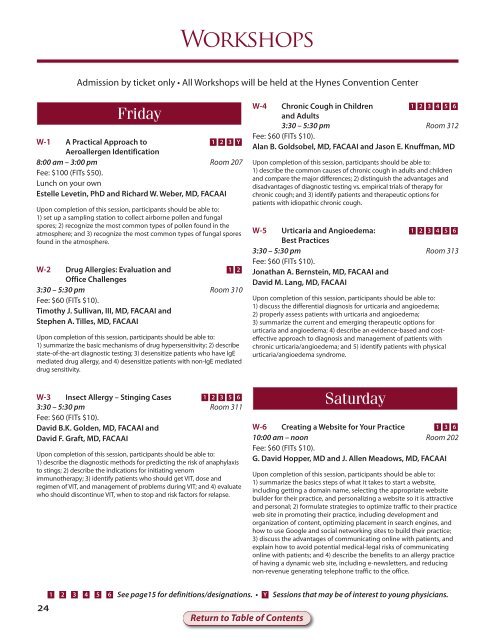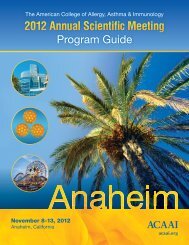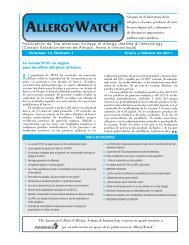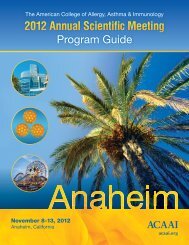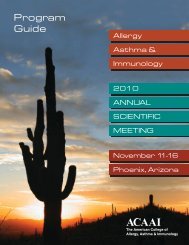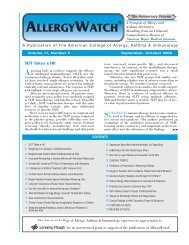WorkshopsAdmission by ticket only • All Workshops will be held at the Hynes Convention CenterFridayW-1 A Practical Approach toAeroallergen Identification1 2 3 Y8:00 am – 3:00 pm Room 207Fee: $100 (FITs $50).Lunch on your ownEstelle Levetin, PhD <strong>and</strong> Richard W. Weber, MD, FACAAIUpon completion <strong>of</strong> this session, participants should be able to:1) set up a sampling station to collect airborne pollen <strong>and</strong> fungalspores; 2) recognize the most common types <strong>of</strong> pollen found in theatmosphere; <strong>and</strong> 3) recognize the most common types <strong>of</strong> fungal sporesfound in the atmosphere.W-2 Drug Allergies: Evaluation <strong>and</strong>Office Challenges1 23:30 – 5:30 pm Room 310Fee: $60 (FITs $10).Timothy J. Sullivan, III, MD, FACAAI <strong>and</strong>Stephen A. Tilles, MD, FACAAIUpon completion <strong>of</strong> this session, participants should be able to:1) summarize the basic mechanisms <strong>of</strong> drug hypersensitivity; 2) describestate-<strong>of</strong>-the-art diagnostic testing; 3) desensitize patients who have IgEmediated drug allergy, <strong>and</strong> 4) desensitize patients with non-IgE mediateddrug sensitivity.W-4 Chronic Cough in Children<strong>and</strong> Adults1 2 3 4 5 63:30 – 5:30 pm Room 312Fee: $60 (FITs $10).Alan B. Goldsobel, MD, FACAAI <strong>and</strong> Jason E. Knuffman, MDUpon completion <strong>of</strong> this session, participants should be able to:1) describe the common causes <strong>of</strong> chronic cough in adults <strong>and</strong> children<strong>and</strong> compare the major differences; 2) distinguish the advantages <strong>and</strong>disadvantages <strong>of</strong> diagnostic testing vs. empirical trials <strong>of</strong> therapy forchronic cough; <strong>and</strong> 3) identify patients <strong>and</strong> therapeutic options forpatients with idiopathic chronic cough.W-5 Urticaria <strong>and</strong> Angioedema:Best Practices1 2 3 4 5 63:30 – 5:30 pm Room 313Fee: $60 (FITs $10).Jonathan A. Bernstein, MD, FACAAI <strong>and</strong>David M. Lang, MD, FACAAIUpon completion <strong>of</strong> this session, participants should be able to:1) discuss the differential diagnosis for urticaria <strong>and</strong> angioedema;2) properly assess patients with urticaria <strong>and</strong> angioedema;3) summarize the current <strong>and</strong> emerging therapeutic options forurticaria <strong>and</strong> angioedema; 4) describe an evidence-based <strong>and</strong> costeffectiveapproach to diagnosis <strong>and</strong> management <strong>of</strong> patients withchronic urticaria/angioedema; <strong>and</strong> 5) identify patients with physicalurticaria/angioedema syndrome.W-3 Insect <strong>Allergy</strong> – Stinging Cases2 3 5 63:30 – 5:30 pm Room 311Fee: $60 (FITs $10).David B.K. Golden, MD, FACAAI <strong>and</strong>David F. Graft, MD, FACAAIUpon completion <strong>of</strong> this session, participants should be able to:1) describe the diagnostic methods for predicting the risk <strong>of</strong> anaphylaxisto stings; 2) describe the indications for initiating venomimmunotherapy; 3) identify patients who should get VIT, dose <strong>and</strong>regimen <strong>of</strong> VIT, <strong>and</strong> management <strong>of</strong> problems during VIT; <strong>and</strong> 4) evaluatewho should discontinue VIT, when to stop <strong>and</strong> risk factors for relapse.1SaturdayW-6 Creating a Website for Your Practice1 3 610:00 am – noon Room 202Fee: $60 (FITs $10).G. David Hopper, MD <strong>and</strong> J. Allen Meadows, MD, FACAAIUpon completion <strong>of</strong> this session, participants should be able to:1) summarize the basics steps <strong>of</strong> what it takes to start a website,including getting a domain name, selecting the appropriate websitebuilder for their practice, <strong>and</strong> personalizing a website so it is attractive<strong>and</strong> personal; 2) formulate strategies to optimize traffic to their practiceweb site in promoting their practice, including development <strong>and</strong>organization <strong>of</strong> content, optimizing placement in search engines, <strong>and</strong>how to use Google <strong>and</strong> social networking sites to build their practice;3) discuss the advantages <strong>of</strong> communicating online with patients, <strong>and</strong>explain how to avoid potential medical-legal risks <strong>of</strong> communicatingonline with patients; <strong>and</strong> 4) describe the benefits to an allergy practice<strong>of</strong> having a dynamic web site, including e-newsletters, <strong>and</strong> reducingnon-revenue generating telephone traffic to the <strong>of</strong>fice.123456See page15 for definitions/designations. • Y Sessions that may be <strong>of</strong> interest to young physicians.24Return to Table <strong>of</strong> Contents
WorkshopsAdmission by ticket only • All Workshops will be held at the Hynes Convention CenterSaturday (continued)W-7 Preparing Your Practice for an EHR 1 3 4 5 61:00 – 3:00 pm Room 202Fee: $60 (FITs $10).David D. Tanner, MD, FACAAI <strong>and</strong>Richard L. Wasserman, MD, PhD, FACAAIUpon completion <strong>of</strong> this session, participants should be able to:1) demonstrate that an <strong>of</strong>fice EMR is part <strong>of</strong> a workflow solution, not justdocumentation; 2) explain how to plan for evaluating EMR systems <strong>and</strong>selecting a vendor; <strong>and</strong> 3) illustrate how staged implementation <strong>of</strong> EMRincreases the likelihood <strong>of</strong> success.W-8 JCAAI Presents <strong>2011</strong> Coding: What’s New<strong>and</strong> Review3 5 6 Y3:30 – 5:30 pm Room 312Fee: $60 (FITs $10).Donald W. Aaronson, MD, JD, MPH, FACAAI <strong>and</strong>Gary N. Gross, MD, FACAAIUpon completion <strong>of</strong> this session, participants should be able to:1) discuss CPT codes <strong>and</strong> requirements for allergists; 2) recognize ICD-9codes for allergy diagnoses; <strong>and</strong> 3) access current resources for helpwith coding.W-9 Introductory Coursein Rhinolaryngoscopy1 2 3 4 5 6 Y3:30 – 5:30 pm Room 210Fee: $60 (FITs $10).Seong H. Cho, MD <strong>and</strong> Jerald W. Koepke, MD, FACAAIUpon completion <strong>of</strong> this session, participants should be able to:1) discuss the surgical anatomy <strong>of</strong> the upper airway, including the nasalcavity, pharynx, <strong>and</strong> larynx; 2) identify normal <strong>and</strong> abnormal anatomy,as well as disease presentations <strong>and</strong> post operative changes found withendoscopic examination <strong>of</strong> the upper airway; <strong>and</strong> 3) identify theindications for, <strong>and</strong> the use <strong>of</strong>, the fiberoptic rhinoscope in theallergist’s <strong>of</strong>fice.W-10 Dermatology Dilemmas:Interesting Dermatology Cases1 2 33:30 – 5:30 pm Room 311Fee: $60 (FITs $10).Luz S. Fonacier, MD, FACAAI <strong>and</strong> Javed Sheikh, MDUpon completion <strong>of</strong> this session, participants should be able to:1) discuss challenging urticaria <strong>and</strong> dermatologic cases in the allergist’s<strong>of</strong>fice; 2) discuss some distinguishing features <strong>of</strong> different causes <strong>of</strong> eczema;3) discuss the distinguishing features which are helpful in diagnosis;4) identify the different approaches to disease work-up; <strong>and</strong> 5) describe thecontroversies in the approach.W-11 Severe <strong>Asthma</strong>: Diagnosis <strong>and</strong> Treatment 1 2 Y3:30 – 5:30 pm Room 202Fee: $60 (FITs $10).Eugene R. Bleecker, MD <strong>and</strong> James T. Li, MD, FACAAIUpon completion <strong>of</strong> this session, participants should be able to:1) identify subgroups <strong>of</strong> severe asthma; <strong>and</strong> 2) utilize diagnostic tests toestablish clear diagnosis <strong>of</strong> severe asthma; <strong>and</strong> 3) describe thetreatment options <strong>and</strong> approaches for patients with severe asthma.W-12 <strong>Allergy</strong> Testing – Optimal Choices<strong>and</strong> Interpretation1 2 3 4 5 63:30 – 5:30 pm Room 310Fee: $60 (FITs $10).Warner W. Carr, MD, FACAAI <strong>and</strong>John J. Oppenheimer, MD, FACAAIUpon completion <strong>of</strong> this session, participants should be able to:1) describe the current burden <strong>of</strong> allergic disease <strong>and</strong> the diagnosticvalue <strong>of</strong> allergy skin testing; 2) identify the factors affecting variability inskin testing; 3) describe the approval process for an allergy skin test; 4)discuss the most current practice parameters on allergy skin testing; 5)use currently available data to determine which skin test device is bestfor their clinical practice; 6) better perform, document <strong>and</strong> interpretskin testing; <strong>and</strong> 7) utilize different forms <strong>of</strong> skin testing <strong>and</strong> variousdevices that can be employed in prick skin testing.This activity is supported byGREER, HollisterStier <strong>Allergy</strong> <strong>and</strong> Lincoln Diagnosticsthrough independent educational grantsconsisting <strong>of</strong> loaned durable equipment.Workshops123456See page15 for definitions/designations. • Y Sessions that may be <strong>of</strong> interest to young physicians.Return to Table <strong>of</strong> Contents25
- Page 3: WelcomeAmerican College of Allergy,
- Page 8 and 9: Greetings from the AllianceWelcome
- Page 10 and 11: Corporate SupportersACAAI appreciat
- Page 12 and 13: Special AnnouncementsAdmission by B
- Page 14 and 15: Special AnnouncementsSpeaker Ready
- Page 16 and 17: Education InformationThis activity
- Page 18 and 19: Daily EventsHOURSAll programs held
- Page 20 and 21: Daily EventsHOURSAll programs held
- Page 22 and 23: Daily EventsHOURSAll programs held
- Page 24 and 25: Daily EventsHOURSAll programs held
- Page 28 and 29: WorkshopsAdmission by ticket only
- Page 30 and 31: WorkshopsAdmission by ticket only
- Page 32 and 33: WorkshopsAdmission by ticket only
- Page 34 and 35: Friday Literature ReviewRooms 302-3
- Page 36 and 37: Friday ProgramRoom 210 • Hynes Co
- Page 38 and 39: Friday Symposia & House of Delegate
- Page 40 and 41: Friday ProgramAnnual Session and Bu
- Page 42 and 43: Saturday General SessionsOpening Ce
- Page 44 and 45: Saturday General SessionsEAACI Symp
- Page 46 and 47: Meet the Professor BreakfastsHynes
- Page 48 and 49: Sunday General SessionsPlenary Sess
- Page 50 and 51: Sunday Concurrent SessionsBallroom
- Page 52 and 53: Sunday Concurrent SessionsBallroom
- Page 54 and 55: Monday General SessionsBreakfast Sy
- Page 56 and 57: Monday General SessionsPlenary Sess
- Page 58 and 59: Monday Concurrent SessionsBallroom
- Page 60 and 61: Monday Concurrent SessionsBallroom
- Page 62 and 63: Annual Business MeetingGrand Ballro
- Page 64 and 65: Advanced Practice Health Care Provi
- Page 66 and 67: Office Administrators CourseRoom 31
- Page 68 and 69: Allied Health Professionals CourseR
- Page 70 and 71: Allied Health Professionals CourseR
- Page 72 and 73: Poster Session12:30 - 1:30 pm, Satu
- Page 74 and 75: Poster Session7212:30 - 1:30 pm, Sa
- Page 76 and 77:
Poster Session12:30 - 1:30 pm, Satu
- Page 78 and 79:
Poster SessionP95P96P97WITHDRAWNP98
- Page 80 and 81:
Poster Session7812:30 - 1:30 pm, Sa
- Page 82 and 83:
Poster Session12:30 - 1:30 pm, Satu
- Page 84 and 85:
Poster Session12:30 - 1:30 pm, Satu
- Page 86 and 87:
Poster Session12:30 - 1:30 pm, Satu
- Page 88 and 89:
Poster Session8612:30 - 1:30 pm, Sa
- Page 90 and 91:
Poster Session12:30 - 1:30 pm, Satu
- Page 92 and 93:
Poster Session12:30 - 1:30 pm, Satu
- Page 94 and 95:
Poster Session9212:30 - 1:30 pm, Sa
- Page 96 and 97:
Poster Session12:30 - 1:30 pm, Satu
- Page 98 and 99:
Poster Session12:30 - 1:30 pm, Satu
- Page 100 and 101:
Plenary & Symposia FacultyGary N. G
- Page 102 and 103:
Faculty IndexNelson, Michael R. . .
- Page 104 and 105:
DisclosuresThomas B. Casale, MD, FA
- Page 106 and 107:
DisclosuresLynda C. Schneider, MD,
- Page 108 and 109:
DisclosuresChallenging Cases for th
- Page 110 and 111:
Special EventsACAAI Awards Ceremony
- Page 112 and 113:
Tribute to Our Past PresidentsPast
- Page 114 and 115:
ACAAI FoundationACAAI Foundation
- Page 116 and 117:
Fellows-in-TrainingAll Fellows-in-T
- Page 118 and 119:
Travel Grant RecipientsThanks to th
- Page 120 and 121:
Travel Grant RecipientsThanks to th
- Page 122 and 123:
Travel Grant RecipientsThanks to th
- Page 124 and 125:
Product TheaterThese are commercial
- Page 126 and 127:
ExhibitsHalls C & D • Hynes Conve
- Page 128 and 129:
ExhibitsHalls C & D • Hynes Conve
- Page 130 and 131:
ExhibitsHalls C & D • Hynes Conve
- Page 132 and 133:
ExhibitsHalls C & D • Hynes Conve
- Page 134 and 135:
ExhibitsHalls C & D • Hynes Conve
- Page 136 and 137:
ExhibitsHalls C & D • Hynes Conve
- Page 138 and 139:
ExhibitsHalls C & D • Hynes Conve
- Page 140 and 141:
ExhibitsHalls C & D • Hynes Conve
- Page 142 and 143:
Index of ExhibitsHalls C & D • Hy
- Page 144 and 145:
Index of ExhibitorsHalls C & D •
- Page 146 and 147:
Exhibit Hall MapRHC133513331331Alle
- Page 148 and 149:
Hynes Convention CenterLevel 2WSout
- Page 150 and 151:
Sheraton Boston Hotel2nd Floor - Pl
- Page 153 and 154:
BRIEF SUMMARY OF FULL PRESCRIBING I
- Page 155 and 156:
Visit us at Booth #419For adolescen


